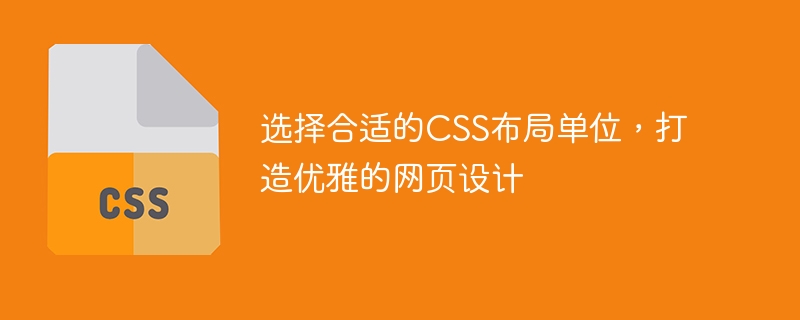

Choose appropriate CSS layout units to create elegant web design
In web design, CSS layout units are a crucial part. Different layout units can help us better control the size, spacing and position of web page elements, thereby creating an elegant and beautiful web design. This article will introduce several common CSS layout units and provide specific code examples.
Pixels are one of the most common CSS layout units. It has a fixed size and is suitable for situations where precise control over the size and position of elements is required. For example, we can set the width of an element to 200 pixels using pixel units:
.element {
width: 200px;
}Percent units are calculated relative to the size of the parent element , which can help us implement responsive layout. By using percentage units, we can automatically resize elements as the screen size changes. For example, we can use percentage units to set the width of an element to 50% of the parent element:
.element {
width: 50%;
}View window units refer to relative Units relative to the size of the browser window. The vw (viewport width) unit represents the ratio relative to the width of the viewport, and the vh (viewport height) unit represents the ratio relative to the height of the viewport. Window units are widely used in responsive design and can dynamically resize elements based on the size of the window.
For example, we can use vw units to set the width of an element to 30% of the viewport width:
.element {
width: 30vw;
}em units The unit is calculated relative to the font size of the parent element, while the rem unit is calculated relative to the font size of the root element (html). em and rem units can help us achieve relative size layout regardless of font size.
For example, we can set the width of an element to 2 times the font size using em units:
.element {
width: 2em;
}Adaptive unit (fr) is a unit in CSS Grid layout that is used to automatically allocate remaining space. The fr unit can help us achieve a layout of evenly distributed elements, especially suitable for grid layout.
For example, we can use the fr unit to implement a simple two-column layout:
.container {
display: grid;
grid-template-columns: 1fr 1fr;
}By choosing the appropriate CSS layout unit, we can more flexibly control the layout of the web page, thereby creating an elegant , beautiful web design. The above are some common CSS layout units, each of which has different characteristics and application scenarios. I hope this article can help you make better use of layout units and improve the quality and effect of web design.
The above is the detailed content of Use the right CSS layout units to create beautiful web designs. For more information, please follow other related articles on the PHP Chinese website!